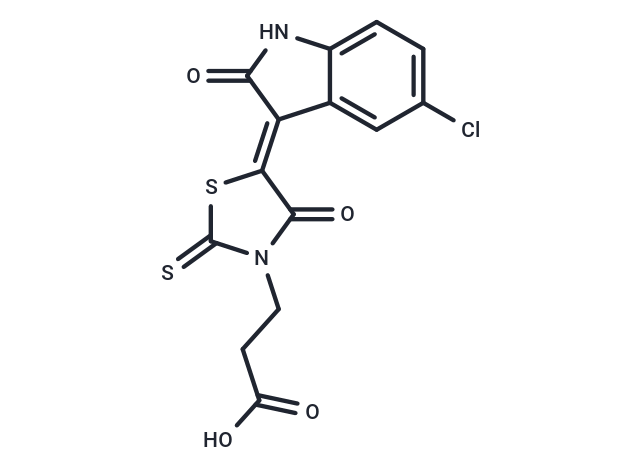Shopping Cart
- Remove All
 Your shopping cart is currently empty
Your shopping cart is currently empty
FX1 is an effective and selective BCL6 inhibitor (IC50: 35 μM).

| Pack Size | Price | Availability | Quantity |
|---|---|---|---|
| 5 mg | $34 | In Stock | |
| 10 mg | $52 | In Stock | |
| 25 mg | $106 | In Stock | |
| 50 mg | $166 | In Stock | |
| 100 mg | $245 | In Stock | |
| 200 mg | $356 | In Stock | |
| 1 mL x 10 mM (in DMSO) | $38 | In Stock |
| Description | FX1 is an effective and selective BCL6 inhibitor (IC50: 35 μM). |
| Targets&IC50 | BCL6 BTB:35 μM |
| In vitro | FX1 markedly reduces recruitment of SMRT and BCOR to all 3 BCL6 target genes. There is little presence of SMRT at these loci in the BCL6-negative DLBCL cell line, which is not affected by FX1. After treatment with 50 μM FX1 for 6 hours, the superior potency of FX1 versus 79-6 in disrupting BCL6 binding to SMRT is evident when these small molecules are compared head to head in quantitative ChIP assays in DLBCL cells. |
| In vivo | Total B cell abundance is unaffected by FX1. FX1 significantly deplete GC B cells (GL7+FAS+B220+). Staining with B220 antibody reveals normal B cell follicular structures, whereas staining for the GC B cell-specific marker peanut agglutinin shows profound loss of GCs. The half-life is estimated to be approximately 12 hours. No signs of toxicity, inflammation, or infection are evident from H&E-stained sections of spleen, lung, gastrointestinal tract, kidney, heart, liver, and bone marrow of the fixed organs from mice treated with FX1 compare with the vehicle. |
| Cell Research | Cell viability is determined with the fluorescent redox dye. Fluorescence is determined for 3 replicates per treatment condition or vehicle with the microplate reader. The drug effect as 100-percentage viability is calculated. Through dose-effect curves the drug concentration that inhibits the growth of cell lines by 50% compared with vehicle (GI50) is determined. Experiments are performed in triplicate. For combination treatments, cells are exposed to a dose curve of each drug alone or their combination in a constant ratio, and cell viability is determined. To compare different schedules of treatments, the cells are treated in triplicate as follows: FX1 and doxorubicin simultaneously and cells treated for 48 hours; FX1 first and 24 hours after doxorubicin is added and treats for an extra 48 hours; doxorubicin first and 24 hours after FX1 is added and treats for an extra 48 hours. Then, the software is used to plot dose-effect curves and calculate the dose-reduction index [1]. |
| Animal Research | Cell viability is determined with the fluorescent redox dye. Fluorescence is determined for 3 replicates per treatment condition or vehicle with the microplate reader. Cell viability of the drug-treated cells is normalized to their vehicle-treated controls, and the results are expressed as percentage viability. The drug effect as 100-percentage viability is calculated. Through dose-effect curves the drug concentration that inhibits the growth of cell lines by 50% compare with vehicle (GI50) is determined. Experiments are performed in triplicate. For combination treatments, cells are exposed to a dose curve of each drug alone or their combination in constant ratio, and cell viability is determined. To compare different schedules of treatments, the cells are treated in triplicate as follows: FX1 and doxorubicin simultaneously and cells treated for 48 hours; FX1 first and 24 hours after doxorubicin is added and treats for an extra 48 hours; doxorubicin first and 24 hours after FX1 is added and treats for an extra 48 hours. Then, the software is used to plot dose-effect curves and calculate the dose-reduction index[1]. |
| Molecular Weight | 368.82 |
| Formula | C14H9ClN2O4S2 |
| Cas No. | 1426138-42-2 |
| Smiles | OC(=O)CCN1C(=S)S\C(C1=O)=C1/C(=O)Nc2ccc(Cl)cc12 |
| Relative Density. | no data available |
| Storage | Powder: -20°C for 3 years | In solvent: -80°C for 1 year | Shipping with blue ice/Shipping at ambient temperature. | ||||||||||||||||||||||||||||||
| Solubility Information | DMSO: 25 mg/mL (67.79 mM), Sonication is recommended. | ||||||||||||||||||||||||||||||
Solution Preparation Table | |||||||||||||||||||||||||||||||
DMSO
| |||||||||||||||||||||||||||||||

Copyright © 2015-2025 TargetMol Chemicals Inc. All Rights Reserved.